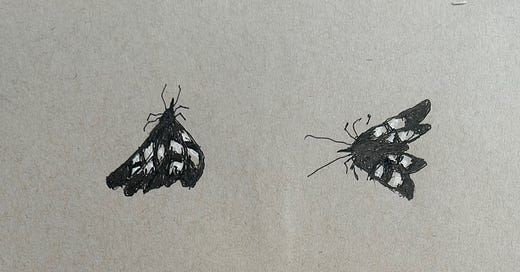Living on the edge Where forsests met open fields Larva feeds on vines
Today’s image is an Eight-spotted Forester Moth. Their caterpillars feed on crossvine and other vines. Adults feed on nectar. I created the drawing from photographs taken on my deck last summer. I wrote the accompanying haiku earlier this week. More Haiku appear at the end of this installment.
Haiga or Haiku Drawing is a traditional art form that combines haiku with visual art. I prepared these notes for a program about it at the Chattanooga Public Library. Participants learned a bit about Haiga and Haiku and created Haiku Drawings.
I drew heavily on The Art of Haiku by Stephen Addiss as I created these notes. The publisher is Shambhala Press, a noteworthy producer of spiritual books.
Haiku authors traditionally combined three art forms: poetry, painting, and calligraphy to create Haiga. Haiku masters wrote with a fine-tipped brush known in English as a calligraphy brush. The haiku art may be elaborate or simple.
They used the same brush and ink to write the poem and to do the painting. They believed the poem did not complete the artwork, nor the artwork complete the poem. Ideally, each was able to stand on its own.
Contemporary Haiga combines haiku with various art forms, including painting, drawing, sculpture, origami, etc. I have read that one contemporary artist created an origami piece and wrote a haiku on its surfaces.
One cannot pursue the subject without examining the story of Haiku. Here is a thumbnail sketch.
Haiku is likely derived from a five-line form called Tanka. The word is sometimes translated as “short song,” but I don’t know if they were sung. The syllable counts for Tanka are 5-7-5-7-7.
Saigyo Hoshu (1118-1190) is the most recognized Tanka poet, and Basho often mentioned him in his journals. Some of his work appears in the second chapter of The Art of Haiku.
Haiku is commonly known as a three-line poem with the 5-7-5 syllable count. In Japanese, it is one vertical line broken into three parts.
Addiss cites many authors who stretched and broke the syllabic format when it suited them. In the 20th century, Haiku poets were divided into those who followed the syllable count and those who did not.
So, if the syllables don’t make it a Haiku, what does? Addiss lists three criteria. Haiku is based in nature. Haiku is not subjective; emotions are implied rather than explicitly stated. Each haiku corresponds to a specific season, and the author may mention the season or use a seasonal word (Kigo). For instance, cherry blossoms signify spring. Seasonal Words Spring: Cherry blossoms, plums, melting snow, azaleas, dogwood flowers, frogs. Summer: cicada, fly, fireworks, mosquito, heron, wind chimes, drought. Autumn: dragonfly, harvest, milky way, pumpkins, scarecrow. Winter: frost, snow, snowflakes, storms. The new year was a popular time for poems. There are seasonal words solely for New Year's Day. 500 Seasonal words appear in this directory.
Kireji are cutting words. In English, we use them in conversation; they are not written, except in dialogue. In Japanese Haiku, they are written and may serve as punctuation. This example is not a great Haiku, but I wrote it to illustrate the concept:
Beautiful pines, ah. Breakers thunder on the shore, ha. Dunes wash away, oh.
Scholars recognize three great haiku masters.
Matsuo Basho, 1644-1694, is regarded as the first among the haiku poets. He created haiga and haiku. He wrote travel journals (haibun) that combined prose and haiku. Narrow Road to the Interior is the best known, but he wrote others. Shambhala Press published a collection.
Basho wrote several collaborative linked haiku in which each author added another haiku to the chain. So, Haiku might be combined with other haiku, prose, or art. Basho had several followers in the Basho school of Haiku.
Yosa Buson, 1716-1784, was first a commercial artist. He added Haiku to his works and is regarded as the great master of Haiga.
Kobayashi Issa, 1763-1828, lived a difficult life and wrote poignant poetry. His works are noted for their connection to all living things. He wrote a Haibun travel journal titled The Spring of My Life.
Addiss also mentions Masaoka Shiki as an important figure. Shiki died at the beginning of the twentieth century and is noted for reviving Haiku and Tanka.
Resources:
Art Online Tutorials (YouTube)
The Laws Guide to Nature Drawing and Journaling
The Nature Journaling Connection
Here are some poems I wrote while attending an open mic.
They follow the syllabic style of haiku, but like many haiku written in English, they are not really haiku. Voice travels fast over rattling pots and pans. It's about a girl. Silent television flashes messages of light. the poets' words shine. She holds her laptop like a seashell in one hand. Speaks beautiful words. He sings us a song. Love lost and found in his words. Tones give it meaning. Gasoline and love songs. Items lost and found in hope. A poets soul is his. Eulogy presents words for deceased Pope and asks what will we do now?





Learned so much and want to try art + haiku! Thank you! 🙏❤️
Such lovely nature studies Ray. Thank you so much for leading our poetry workshop during book club a couple of days ago. And thank you for sharing here too. Always enjoy seeing what you're creating. - Alex